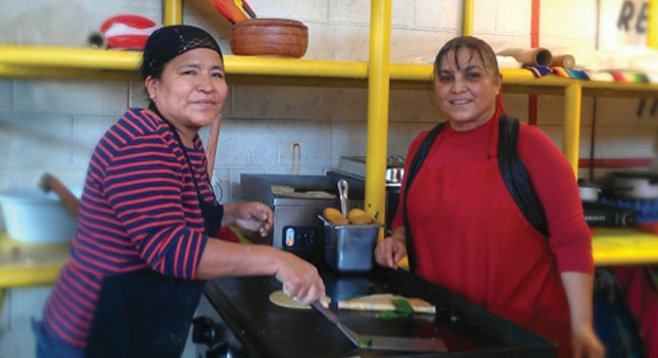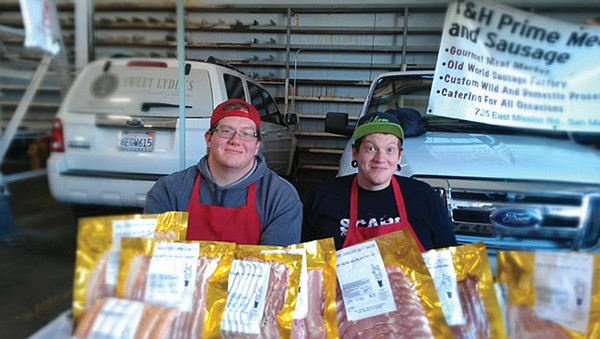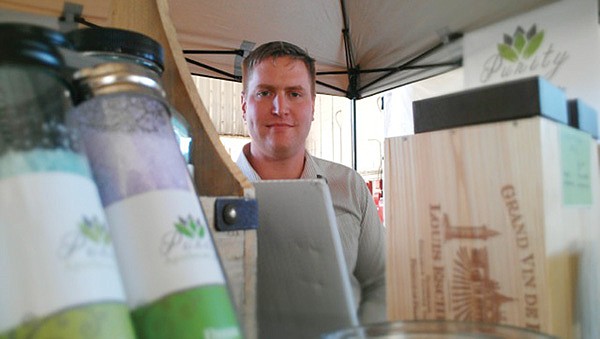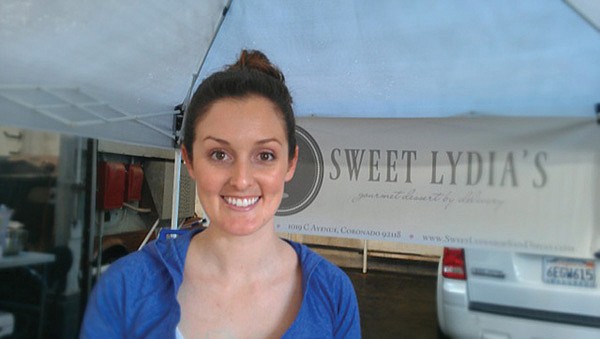 Facebook
Facebook
 X
X
 Instagram
Instagram
 TikTok
TikTok
 Youtube
Youtube

Every Wednesday and Sunday morning, Saida Soto and three co-workers spend an hour setting up their two booths at the San Diego Public Market on National Avenue in Barrio Logan. They lug their two griddles, a tortilla warmer, two hot plates, a five-gallon jug of water, and all the tamales, tortillas, eggs, cheese, and vegetables they can sell in a day to the market. And every Wednesday and Sunday afternoon, the four of them spend another hour packing up their gear and returning it to the New Mexico Café around the corner.
Soto has her fingers crossed that in the next few months she’ll have a permanent booth in the market, and the hauling and heavy lifting will no longer be necessary.
Catt White, co-founder (with Dale Steele) of the market, which currently operates on Wednesdays and Sundays only, says she’s shooting for a June 20 opening of the permanent market she’s been planning all along. And although she’s hesitant to guarantee that date, she does promise that the process is in motion.
“It’s kind of an enormous construction project,” she tells me one Wednesday afternoon. We’re sitting at a table outside the market, and her brief hurried answers make it clear that she’s a busy woman with not a lot of time to chat.
“There are parts that we do, where we stub in electric and plumbing and such to the individual spaces. And then when the tenants come in, they get to design their spaces, and then there’s the improvement construction.”
The total number of permanent spaces, White says, will be between 45 and 65, depending on the square-footage needs of the tenants. She declines to answer how much she will charge to lease each space, offering only that the range will vary widely.
“We’ve got some tenants that want 400 and 800 square feet, and we’ve got tenants that only want 120 square feet, so depending on who we choose from the proposals, we may end up with more,” she says. “Generally speaking, we’re more inclined to go with a lot of small spaces so we have a diversity of offerings.”

Just inside the market’s northwestern entrance, Corey and Andrew Bilbrey man the T&H Prime Meats and Sausage booth. The two brothers are not owners, but they manage the company’s farmers’ market sales, and as such, are the ones who pack up the meat in the coolers and drive back and forth from San Marcos on market days. T&H has sent their proposal in, and in the event that T&H is among those chosen for a permanent lease space, older brother Corey says the top item on their list of design priorities will be a freezer with glass doors.
“The bulk of our sausage we have to keep frozen,” Corey says, opening a cooler in the back of the truck behind his booth to show me the frozen meat. “By having a permanent stall, we’d be able to keep these in a bigger supply and have them on display at all times.”

Gary Francisco, who owns Purity Apothecary with his wife Christina Price, also awaits word from White about his company’s proposal. A permanent stall with shelving, sinks, and electricity will allow him to have a workspace to make the soaps and other natural skin-care products he and his wife sell. Currently, they rent an industrial kitchen for $1000 a month. A permanent space would eliminate that expense. It would also eliminate the amount of wear-and-tear the labels incur each time they’re packed, unpacked, and put on display. [As of the last week of February, Christina Price says market organizers have accepted her application and approved her space requirements, but they have not yet provided the numbers for her monthly lease.]
Although Francisco and Price also sell at Little Italy and North Park farmers’ markets, Francisco says they’ll prioritize the permanent spot. “We’ll experiment with staying at the other markets,” Francisco says, “but we’d have to work out the numbers because that would require employees.”
While many of the market’s current vendors are, like Bilbrey and Francisco, eager for a chance to get in on the ground floor of this new project, others are more trepidacious. Lydia Perkins is one of the latter.

The 26-year-old owner of Sweet Lydia’s, a gourmet dessert company, says, “It’s an incredible project with a lot of potential, and they’re putting a lot of money into it.” But she needs some questions answered before she decides whether it’s the best investment for her. Perkins’s proposal is for a full-service bakery so she can, like Francisco, use the space to both create and sell her products.
“We need to talk numbers,” she says, “but I also need to know if I’m going to have a lot of competition. Who are my neighbors going to be? Are they going to have an eye for detail like I do when they set up their shop? Are there going to be empty spaces next to me? What are they going to do to get traffic in here? What’s the parking going to be like?”
In the meantime, while she waits to sit down with White, get her questions answered, and start negotiations, she’s keeping her eye out for potential storefront space in Coronado, where she lives and currently rents a kitchen. When leases are signed and construction begins, the Wednesday/Sunday farmers’ market will be moved from the warehouse to the 29,000-square-foot plaza at the east of the building. Both the warehouse’s eastern wall and the plaza’s corrugated metal gate will be opened up to create easy access between the permanent and farmers’ markets. On non-market days, the plaza will be used for fundraisers, special events, and weddings.
White won’t share any names of any businesses she has already chosen and with whom she’s currently in negotiation, but she says they’re all local and hints that some are “big names.” She also makes it clear that unlike, say, San Francisco’s Fisherman’s Wharf, where its expensive and vendors have to “have a certain financial level” to lease a space, she wants the San Diego Public Market to be “reachable” for start-ups and smaller businesses such as New Mexico Café.
Soto and her co-workers want the same thing. And while they would love to eliminate the hours spent hauling their griddles back and forth, they can’t promise they’ll end up leasing a permanent stall.
“It depends,” Soto says. “We hope they give us a break.”


Every Wednesday and Sunday morning, Saida Soto and three co-workers spend an hour setting up their two booths at the San Diego Public Market on National Avenue in Barrio Logan. They lug their two griddles, a tortilla warmer, two hot plates, a five-gallon jug of water, and all the tamales, tortillas, eggs, cheese, and vegetables they can sell in a day to the market. And every Wednesday and Sunday afternoon, the four of them spend another hour packing up their gear and returning it to the New Mexico Café around the corner.
Soto has her fingers crossed that in the next few months she’ll have a permanent booth in the market, and the hauling and heavy lifting will no longer be necessary.
Catt White, co-founder (with Dale Steele) of the market, which currently operates on Wednesdays and Sundays only, says she’s shooting for a June 20 opening of the permanent market she’s been planning all along. And although she’s hesitant to guarantee that date, she does promise that the process is in motion.
“It’s kind of an enormous construction project,” she tells me one Wednesday afternoon. We’re sitting at a table outside the market, and her brief hurried answers make it clear that she’s a busy woman with not a lot of time to chat.
“There are parts that we do, where we stub in electric and plumbing and such to the individual spaces. And then when the tenants come in, they get to design their spaces, and then there’s the improvement construction.”
The total number of permanent spaces, White says, will be between 45 and 65, depending on the square-footage needs of the tenants. She declines to answer how much she will charge to lease each space, offering only that the range will vary widely.
“We’ve got some tenants that want 400 and 800 square feet, and we’ve got tenants that only want 120 square feet, so depending on who we choose from the proposals, we may end up with more,” she says. “Generally speaking, we’re more inclined to go with a lot of small spaces so we have a diversity of offerings.”

Just inside the market’s northwestern entrance, Corey and Andrew Bilbrey man the T&H Prime Meats and Sausage booth. The two brothers are not owners, but they manage the company’s farmers’ market sales, and as such, are the ones who pack up the meat in the coolers and drive back and forth from San Marcos on market days. T&H has sent their proposal in, and in the event that T&H is among those chosen for a permanent lease space, older brother Corey says the top item on their list of design priorities will be a freezer with glass doors.
“The bulk of our sausage we have to keep frozen,” Corey says, opening a cooler in the back of the truck behind his booth to show me the frozen meat. “By having a permanent stall, we’d be able to keep these in a bigger supply and have them on display at all times.”

Gary Francisco, who owns Purity Apothecary with his wife Christina Price, also awaits word from White about his company’s proposal. A permanent stall with shelving, sinks, and electricity will allow him to have a workspace to make the soaps and other natural skin-care products he and his wife sell. Currently, they rent an industrial kitchen for $1000 a month. A permanent space would eliminate that expense. It would also eliminate the amount of wear-and-tear the labels incur each time they’re packed, unpacked, and put on display. [As of the last week of February, Christina Price says market organizers have accepted her application and approved her space requirements, but they have not yet provided the numbers for her monthly lease.]
Although Francisco and Price also sell at Little Italy and North Park farmers’ markets, Francisco says they’ll prioritize the permanent spot. “We’ll experiment with staying at the other markets,” Francisco says, “but we’d have to work out the numbers because that would require employees.”
While many of the market’s current vendors are, like Bilbrey and Francisco, eager for a chance to get in on the ground floor of this new project, others are more trepidacious. Lydia Perkins is one of the latter.

The 26-year-old owner of Sweet Lydia’s, a gourmet dessert company, says, “It’s an incredible project with a lot of potential, and they’re putting a lot of money into it.” But she needs some questions answered before she decides whether it’s the best investment for her. Perkins’s proposal is for a full-service bakery so she can, like Francisco, use the space to both create and sell her products.
“We need to talk numbers,” she says, “but I also need to know if I’m going to have a lot of competition. Who are my neighbors going to be? Are they going to have an eye for detail like I do when they set up their shop? Are there going to be empty spaces next to me? What are they going to do to get traffic in here? What’s the parking going to be like?”
In the meantime, while she waits to sit down with White, get her questions answered, and start negotiations, she’s keeping her eye out for potential storefront space in Coronado, where she lives and currently rents a kitchen. When leases are signed and construction begins, the Wednesday/Sunday farmers’ market will be moved from the warehouse to the 29,000-square-foot plaza at the east of the building. Both the warehouse’s eastern wall and the plaza’s corrugated metal gate will be opened up to create easy access between the permanent and farmers’ markets. On non-market days, the plaza will be used for fundraisers, special events, and weddings.
White won’t share any names of any businesses she has already chosen and with whom she’s currently in negotiation, but she says they’re all local and hints that some are “big names.” She also makes it clear that unlike, say, San Francisco’s Fisherman’s Wharf, where its expensive and vendors have to “have a certain financial level” to lease a space, she wants the San Diego Public Market to be “reachable” for start-ups and smaller businesses such as New Mexico Café.
Soto and her co-workers want the same thing. And while they would love to eliminate the hours spent hauling their griddles back and forth, they can’t promise they’ll end up leasing a permanent stall.
“It depends,” Soto says. “We hope they give us a break.”
Comments